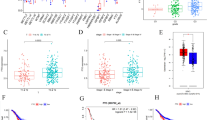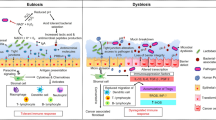Abstract
The aim of this study was to investigate the relationship between the H-ras and Cox-2 gene expression in tumors from Iranian Oral Squamous Cell Carcinoma (OSCC) patients. Fresh tumor biopsies removed from oral cavity were collected from 67 new cases. Total RNA was extracted from biopsies and processed for quantification of H-ras and Cox-2 specific RNA expression using real-time PCR (QPCR). In addition, 59 gingival biopsies from apparently normal individuals were processed for QPCR assays. The results showed that Cox-2 expression at mRNA levels was at minimal levels in normal gingival biopsies. However, there was a surge in Cox-2 expression in tumor tissues (11.5 fold, p < 0.0001). Cox-2 expression was elevated depending on the tumor grade and there was a 1.7 fold increase (p = 0.003) in tumors diagnosed as MD/PD compared to that pathologically diagnosed as WD. This inflammatory marker was increased more significantly in smoker patients compared to non-smoker matching group. The H-ras expression at mRNA levels was significantly higher in OSCC samples compared to normal gingival (3 fold; p = 0.044). This expression was significantly higher in tumors diagnosed as MD/PD compared to WD (1.59 fold, p = 0.033). In conclusion, we found a correlation between H-ras expression and Cox-2 induction in OSCC tissue, suggesting that together these genes are contributing to cancer progression. Cox-2 is an early event in cancers of mucosal epithelial cells and a surge in Cox-2 expression in OSCC could be partly due to pro-inflammatory factors such as smoking.


Similar content being viewed by others
References
Li TJ, Cui J (2013) COX-2, MMP-7 expression in oral lichen planus and oral squamous cell carcinoma. Asian Pac J Trop Med 6(8):640–643. doi:10.1016/S1995-7645(13)60110-8
Li D, Hao SH, Sun Y, Hu CM, Ma ZH, Wang ZM, Liu J, Liu HB, Ye M, Zhang YF, Yang DS, Shi G (2015) Functional polymorphisms in COX-2 gene are correlated with the risk of oral cancer. Biomed Res Int 2015:580652. doi:10.1155/2015/580652
Warnakulasuriya S (2010) Living with oral cancer: epidemiology with particular reference to prevalence and life-style changes that influence survival. Oral Oncol 46(6):407–410. doi:10.1016/j.oraloncology.2010.02.015
Yu KT, Ge C, Xu XF, Zou JC, Zou X, Zhen S (2014) CYP1A1 polymorphism interactions with smoking status in oral cancer risk: evidence from epidemiological studies. Tumour Biol 35(11):11183–11191. doi:10.1007/s13277-014-2422-y
Sand L, Wallstrom M, Hirsch JM (2014) Smokeless tobacco, viruses and oral cancer. Oral Health Dent Manag 13(2):372–378
Vlachopoulos C, Aznaouridis K, Bratsas A, Ioakeimidis N, Dima I, Xaplanteris P, Stefanadis C, Tousoulis D (2015) Arterial stiffening and systemic endothelial activation induced by smoking: the role of COX-1 and COX-2. Int J Cardiol 189:293–298. doi:10.1016/j.ijcard.2015.04.029
Ricciotti E, FitzGerald GA (2011) Prostaglandins and inflammation. Arterioscler Thromb Vasc Biol 31(5):986–1000. doi:10.1161/ATVBAHA.110.207449
Hamzic N, Blomqvist A, Nilsberth C (2013) Immune-induced expression of lipocalin-2 in brain endothelial cells: relationship with interleukin-6, cyclooxygenase-2 and the febrile response. J Neuroendocrinol 25(3):271–280. doi:10.1111/jne.12000
Pandey M, Prakash O, Santhi WS, Soumithran CS, Pillai RM (2008) Overexpression of COX-2 gene in oral cancer is independent of stage of disease and degree of differentiation. Int J Oral Maxillofac Surg 37(4):379–383. doi:10.1016/j.ijom.2008.01.004
He XP, Shao Y, Li XL, Xu W, Chen GS, Sun HH, Xu HC, Xu X, Tang D, Zheng XF, Xue YP, Huang GC, Sun WH (2012) Downregulation of miR-101 in gastric cancer correlates with cyclooxygenase-2 overexpression and tumor growth. FEBS J 279(22):4201–4212. doi:10.1111/febs.12013
Wu QB, Sun GP (2015) Expression of COX-2 and HER-2 in colorectal cancer and their correlation. World J Gastroenterol 21(20):6206–6214. doi:10.3748/wjg.v21.i20.6206
Allameh A, Rasmi Y, Nasseri-Moghaddam S, Tavangar SM, Sharifi R, Sadreddini M (2009) Immunohistochemical analysis of selected molecular markers in esophagus precancerous, adenocarcinoma and squamous cell carcinoma in Iranian subjects. Cancer Epidemiol 33(1):79–84. doi:10.1016/j.canep.2009.05.002
Biramijamal F, Allameh A, Mirbod P, Groene HJ, Koomagi R, Hollstein M (2001) Unusual profile and high prevalence of p53 mutations in esophageal squamous cell carcinomas from northern Iran. Cancer Res 61(7):3119–3123
Liu B, Qu L, Yan S (2015) Cyclooxygenase-2 promotes tumor growth and suppresses tumor immunity. Cancer Cell Int 15. doi:10.1186/s12935-015-0260-7
Taketomi A, Shirabe K, Muto J, Yoshiya S, Motomura T, Mano Y, Ikegami T, Yoshizumi T, Sugio K, Maehara Y (2013) A rare point mutation in the ras oncogene in hepatocellular carcinoma. Surg Today 43(3):289–292. doi:10.1007/s00595-012-0462-8
Wang Y, Arlt VM, Roufosse CA, McKim KL, Myers MB, Phillips DH, Parsons BL (2012) ACB-PCR measurement of H-ras codon 61 CAA-->CTA mutation provides an early indication of aristolochic acid I carcinogenic effect in tumor target tissues. Environ Mol Mutagen 53(7):495–504. doi:10.1002/em.21710
Sen B, Peng S, Saigal B, Williams MD, Johnson FM (2011) Distinct interactions between c-Src and c-met in mediating resistance to c-Src inhibition in head and neck cancer. Clin Cancer Res 17(3):514–524. doi:10.1158/1078-0432.CCR-10-1617
Murugan AK, Munirajan AK, Tsuchida N (2012) Ras oncogenes in oral cancer: the past 20 years. Oral Oncol 48(5):383–392. doi:10.1016/j.oraloncology.2011.12.006
Chang F, Steelman LS, Shelton JG, Lee JT, Navolanic PM, Blalock WL, Franklin R, McCubrey JA (2003) Regulation of cell cycle progression and apoptosis by the ras/Raf/MEK/ERK pathway (review. Int J Oncol 22(3):469–480
Vairaktaris E, Papakosta V, Derka S, Vassiliou S, Nkenke E, Spyridonidou S, Vylliotis A, Lazaris A, Kokkori A, Moulavassili P, Loukeri S, Perrea D, Donta I, Yapijakis C, Patsouris E (2008) H-ras and c-fos exhibit similar expression patterns during most stages of oral oncogenesis. In Vivo 22(5):621–628
Sathyan KM, Nalinakumari KR, Kannan S (2007) H-ras mutation modulates the expression of major cell cycle regulatory proteins and disease prognosis in oral carcinoma. Mod Pathol 20(11):1141–1148. doi:10.1038/modpathol.3800948
Wong CE, Yu JS, Quigley DA, To MD, Jen KY, Huang PY, Del Rosario R, Balmain A (2013) Inflammation and Hras signaling control epithelial-mesenchymal transition during skin tumor progression. Genes Dev 27(6):670–682. doi:10.1101/gad.210427.112
Lee KW, Kim MS, Kang NJ, Kim DH, Surh YJ, Lee HJ, Moon A (2006) H-ras selectively up-regulates MMP-9 and COX-2 through activation of ERK1/2 and NF-kappaB: an implication for invasive phenotype in rat liver epithelial cells. Int J Cancer 119(8):1767–1775. doi:10.1002/ijc.22056
Lingen MW, Kalmar JR, Karrison T, Speight PM (2008) Critical evaluation of diagnostic aids for the detection of oral cancer. Oral Oncol 44(1):10–22. doi:10.1016/j.oraloncology.2007.06.011
Nguyen T, Tang Z, Younes M, Alsarraj A, Ramsey D, Fitzgerald S, Kramer JR, El-Serag HB (2015) Esophageal COX-2 expression is increased in Barrett’s esophagus, obesity, and smoking. Dig Dis Sci 60(1):65–73. doi:10.1007/s10620-014-3333-x
Fujii R, Imanishi Y, Shibata K, Sakai N, Sakamoto K, Shigetomi S, Habu N, Otsuka K, Sato Y, Watanabe Y, Ozawa H, Tomita T, Kameyama K, Fujii M, Ogawa K (2014) Restoration of E-cadherin expression by selective cox-2 inhibition and the clinical relevance of the epithelial-to-mesenchymal transition in head and neck squamous cell carcinoma. J Exp Clin Cancer Res 33. doi:10.1186/1756-9966-33-40
Liu ES, Shin VY, Ye YN, Luo JC, WK W, Cho CH (2005) Cyclooxygenase-2 in cancer cells and macrophages induces colon cancer cell growth by cigarette smoke extract. Eur J Pharmacol 518(1):47–55. doi:10.1016/j.ejphar.2005.05.018
Acknowledgements
This article is part of the PhD dissertation of A. Moazeni-Roodi. This study has been supported by Tehran University of Medical Sciences and Health Services, Grant #92-02-51-23399.
Author information
Authors and Affiliations
Corresponding author
Rights and permissions
About this article
Cite this article
Moazeni-Roodi, A., Allameh, A., Harirchi, I. et al. Studies on the Contribution of Cox-2 Expression in the Progression of Oral Squamous Cell Carcinoma and H-Ras Activation. Pathol. Oncol. Res. 23, 355–360 (2017). https://doi.org/10.1007/s12253-016-0114-1
Received:
Accepted:
Published:
Issue Date:
DOI: https://doi.org/10.1007/s12253-016-0114-1




